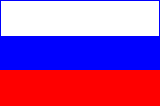
 
The Russian Federation, (the Russian Federative Republic), has existed since 1991 but was set by the Constitution, and approved on December 12, 1993, by the whole population referendum. According to the Constitution, Russia consists of 89 sovereign parts called subjects. Their rights are similar to rights of American states. Subjects have their own parliaments and governments and their legislation, which do not contradict the federal legislation. 21 of the subjects, mostly populated by non-Russians, call themselves Republics. They have their own Constitutions and 2 official languages.
Under the Constitution, Russia is a Presidential Republic. The federal government consists of 3 branches: Legislative, Executive and Judicial. Each of them is checked and balanced by the President who is the head of the state. He is the Commander-in-Chief of the armed forces, he establishes decrees, determines the major directions of internal and external policy, nominates ministers of the government, and appoints the Prime Minister to be approved by the Federal Assembly. He can even dissolute the parliament in some cases. The President is elected by the population every 4 years. He must be a Russian citizen older than 35 year’s old who has lived in Russia for at least 10 years. Each person who is elected can only be elected as the President twice.
The legislative power is vested in the Federal Assembly. It consists of two chambers: the Council of Federation (the upper chamber) and the State Duma (the lower chamber). The Council of Federation consists of heads of subjects (2 from each subject). The State Duma includes 450 representatives of the population. Each chamber is headed by the Speaker. Legislature is initiated in each of the two chambers, by the President or by the members of the government. However a bill must be approved by both chambers and signed by the President to become a law. The President has the power to veto a bill approved by the Parliament. Deputies of The State Duma are elected by the population every 4 years from Russian citizens older than 21 year’s old. The Parliament sessions are opened for public.
 Every Russian citizen who isn’t imprisoned and doesn’t have any mental health problems can vote in any elections and referendums from the age of 18.
The executive power belongs to the Government headed by the Prime Minister responsible to the President. Each minister leads his ministry that rules a certain direction of external or internal politics. The Government is changed by every new President.
Every Russian citizen who isn’t imprisoned and doesn’t have any mental health problems can vote in any elections and referendums from the age of 18.
The executive power belongs to the Government headed by the Prime Minister responsible to the President. Each minister leads his ministry that rules a certain direction of external or internal politics. The Government is changed by every new President.
The judicial branch is represented by the Constitutional court, the Supreme Court and regional courts. Only Russian citizens older than 25 years old having higher law education and 5 years working experience in this sphere can work as a judge. The Constitutional court consisting of 19 judges answers the question about conformity of any normative acts to the Constitution.
Russians cites, towns and villages have their own municipal governments headed by the Governor and assemblies of representatives (they could have different names e.g. the city Duma, the city Assembly )elected by the population making decisions on certain local questions (constructions of roads, public buildings, school education, municipal hospitals and so on). Assemblies and Governors are elected by the population from inhabitants of certain cities every 4 or 5 years.
Today the state symbol of Russia is a three-colored banner. The white stripe symbolizes the Earth, the blue stripe symbolizes the sky, the red stripe symbolizes liberty. It was the first state symbol that replaced the Soviet symbols in 1991. For some years the hymn of Russia was “The Patriotic Song” by the famous Russian composer Michail Glinka taken from his opera without any words. Now, it is the Soviet hymn “The Glory Fatherland” by Alexandrov again, with slightly different words. The national emblem is a two-headed eagle. The head on the left looks on the side of Europe, the other one looks on the side of Asia, because Russia is situated on the two continents. It originates from the heraldic emblem of the first Russian tsars Ruricovitch. These symbols are official.
The Constitution is the main countries law and all the rest normative acts must conform to this constitution. Different spheres of people’s life are regulated by the state laws established by the Parliament and united in Codexes, local laws, the Presidents decrees and the Parliament and the courts decisions. According to the Constitution and other laws, Russian citizens have all of the same civil and political rights as citizens of the European Union (according to international pacts signed by Russia) and they have a right to protect them through the court.
Written and Copyrighted; Not to be Shown.
|

